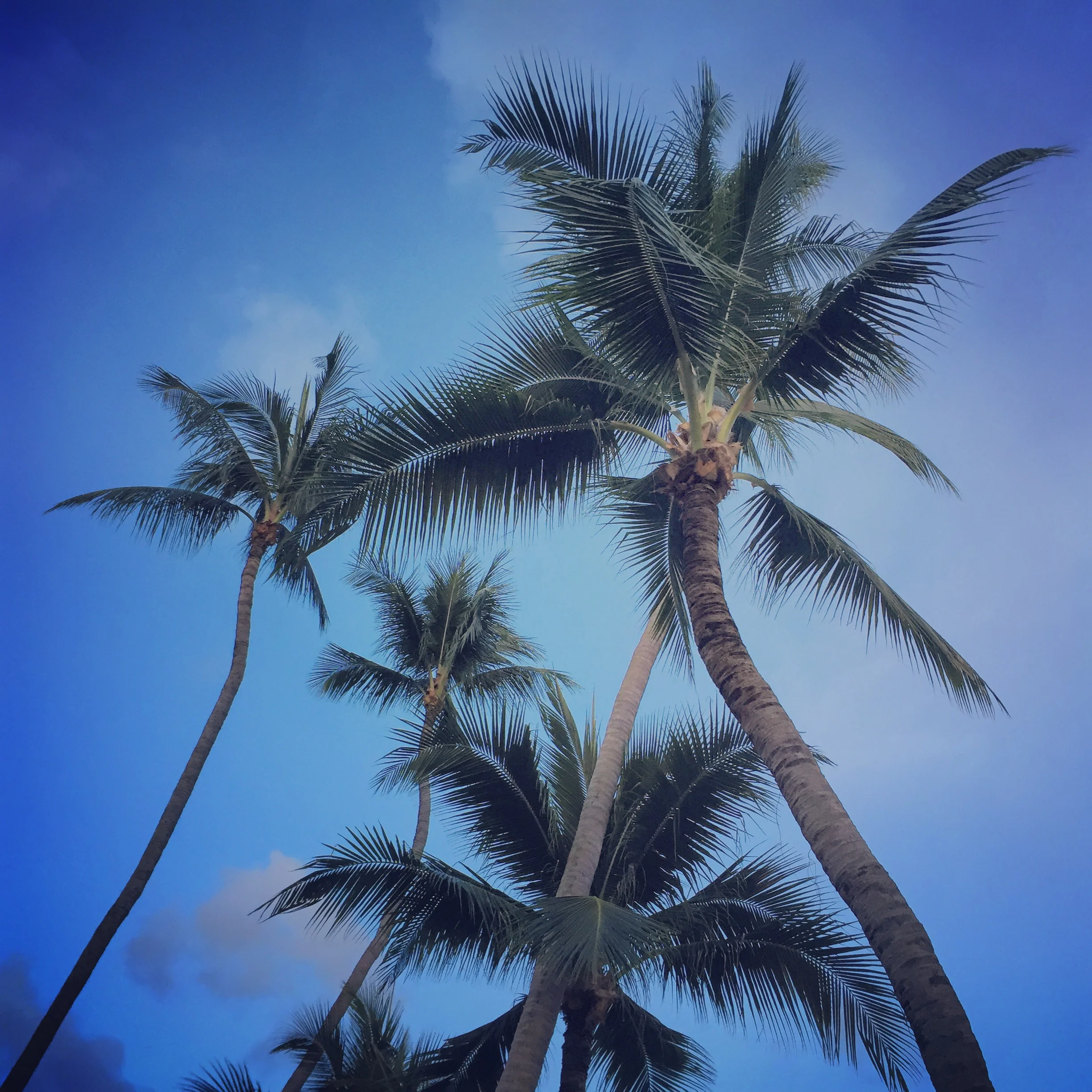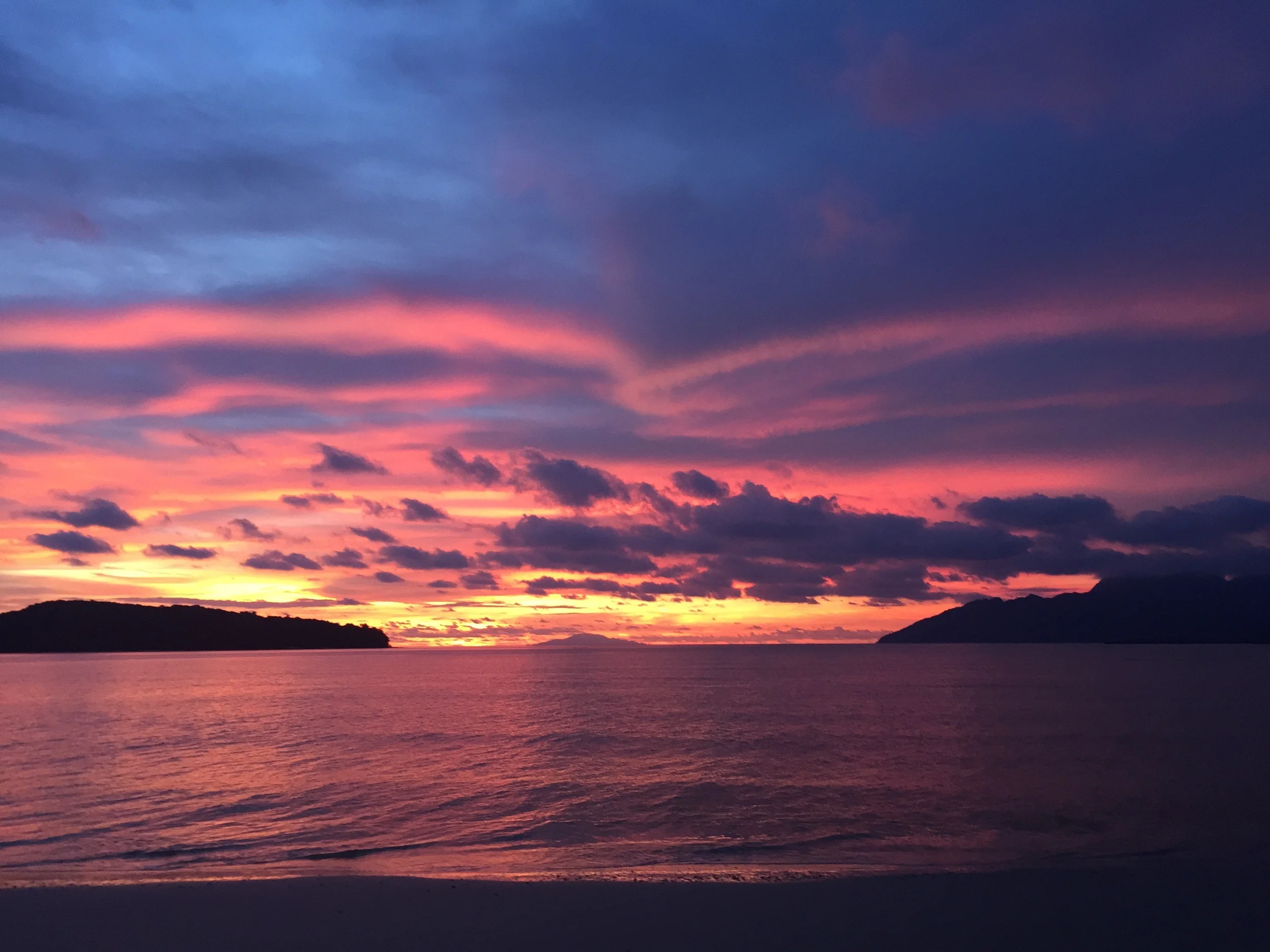Palomino is a serene little beach town about four or five hours from Cartagena (OK, more like 6, even if you take a private minivan), with a soft, sandy beach that meets a dramatic Caribbean Ocean. While palms gently frame the shore, their fronds swaying lazily in the warm, tropical air, the ocean is not the aquamarine, placid waters of a postcard. Instead, the waves crashing on to the beach are large, loud, dramatic — and supposedly underneath have such treacherous currents that (according to my Lonely Planet at least), swimming is rarely advisable.
Cabanas set amidst the palm trees at La Sirena eco lodge in Palomino, Colombia
We left Cartagena yesterday after a taking 5 days of intensive Spanish lessons at a place called Nueva Lengua. It was 4 hours of grammar and conversation classes in the mornings, plus dance instruction in the afternoons (2 hours on Monday and Tuesday, 1 hour on Wednesday) learning salsa and bachata. The week went by in an absolute blur; between class, meeting other students, eating a quick menu del dia at a nearby restaurant for lunch, dashing back to school for salsa, doing homework and heading out for dinner and drinks, I barely had time to stop and think, let alone see much else of Cartagena (although we did go on a tour the school offered of the Museo de Arte Moderno de Cartagena). Finally on Thursday afternoon, I had a chance to start researching and planning how to spend the rest of my time in Colombia. The advantage of a short time is having a much more generous budget with which to travel, but the downside is wanting to see a lot and needing to be efficient with my time.
Our school made reservations for us to get to Cartagena by a private minibus company, which made getting to Palomino easy peasy, although the trip still took a couple hours longer than expected. We had the chance to see some of the gorgeous countryside along the way, including a couple stretches where we drove right along the coastline with waves pounding down almost on the pavement, as well as the Parque Nacional de Tayrona, which seems very lovely. We also had a chance to finally see some of the real Colombia; Cartagena is utterly gorgeous with all its old colonial architecture and charm and tourists, but being there for a full week felt a bit like being in quite a bubble, especially when compared with the small villages and houses we passed along the way being mostly modest, small, simple structures made of concrete and corrugated metal roofs, with most roads unpaved and most cafés open air establishments decked out with plastic furniture.
Playa Palomino's chilled out strip of beachy heaven
We arrived on Palomino and got to take mototaxis to La Sirena, the ecolodge where we're staying — during my four months in Southeast Asia last year I really developed a love for riding on the back of a motorbike, so this last segment of the journey made me giddy with excitement (plus it brought back all sorts of wonderful memories from my time in SE Asia, that feeling of bouncing along on a dirt road on the way to the next adventure). We drove down the main road for a few minutes or two before turning off on a dirt road and continuing on a dirt road for a while longer. And then finally, we arrived into a perfect little oasis filled with thatched roofed cabanas and palm trees and bushes sporting hibiscus flowers, a view of the waves crashing onto the shore in the distance. And, as I fell asleep listening to the roar and rhythm of the waves as the cicadas chirped, the long day spent getting here was definitely worth it.
Today, I arranged to go on a walk in the Sierra Nevada. I wasn't sure what to expect, other than that I knew I'd have a guide and would visit the village of an 'indigenous tribe.' Having been through some touristy parts of Sapa in Vietnam where the 'indigenous tribes' are trying to aggressively sell you handmade wares, or some treks I read about in parts of northern Thailand where you visit an 'indigenous tribe' where hundreds of tourists go everyday to gawk at the long-necked women, or whatever. In other words, I was expecting to find myself on some very touristy experience but whatever, I wanted to go for a walk in the woods, you know?
Jairo, my local guide for my "caminata a la Sierra"
However, when the guide, Jairo, showed up at the eco lodge today, I was surprised when I asked him how many people we'd be and he said it would just be me! This also meant that I would get to spend the entire day speaking in Spanish with him as he spoke literally not a single word of English, so hey, free private conversational Spanish class! Woo hoo! (Although trying to think of how to say things in Spanish while also trying to navigate my way down a rocky, steep, slippery trail is pretty much impossible for me; cut to me going "no puedo hablar ahora, puedo hacer solo una cosa a uno tiempo, por favor" in slow, terrible Spanish more than once).
The Río Palomino, which flows from the Sierra Nevada de Santa Marta into the Caribbean Ocean
After we'd walked for about an hour, we arrived at a cluster of five or six thatched roof huts, all circularly-shaped, which Jairo told me was a local Kogi village. He asked if I wanted to go in, and asked for 10,000 pesos to give to a member of the tribe to enter, which he handed over along while exchanging a small handful of coca leaves with the Kogi man who seemed to represent the tribe. I was able to wander around for a second, but the area was mostly empty, except for all the women congregated cutting up a huge amount of meat near a large pot simmering a liquid over a fire in the center of a large, open air communal kitchen. Next to one of the giant pots of cut up meat was another large bucket filled with what looked like intestines. I asked my guide, who said the meat was vaca (cow). The village was absolutely spotless, clean as can be for a collection of thatched houses sitting on dirt, without a speck of trash anywhere. And, unlike my experiences in Vietnam where it felt like the locals were "putting on the show" for money, this felt refreshingly authentic in that no one was trying to sell me anything, nor did the kids come running up with their hands out in the hopes of getting money or candy. Fair enough, I am travelling a little off season and maybe things are more crowded here when it's high season, but the tribe didn't seem wholly corrupted. (I also asked if I could take pictures and was told no.)
Healthy breakfasts with ocean views at La Sirena
The guide and I continued walking for about an hour more, at times taking in some nice views of the Río Palomino, which flows into the Caribbean Ocean from the Sierra Nevada de Santa Marta, and was mostly empty, minus a few children we saw either playing or collecting shells along the river (whether they were Kogi or local children from Palomino was unclear, too). In fact, the only other person we saw was a friend of the guide's who was sleeping on a rock next to the river after we'd hiked for about two hours. They, too, exchanged a handful of coca leaves, then spent a while admiring some strange wood device the other had, which I think was meant for crushing the coca leaves. (Jairo spent various parts of our hike ingesting coca, using a contraption that grinds the leaves into a fine powder, which he'd injest by licking a long wooden stick that he'd dip into the powder, lick off, then wipe the saliva off on to the top of the contraption, which had turned yellow after time. No, I didn't try it, mostly because um, ew?)
I got back to La Sirena and had a leisurely lunch, followed by some leisurely time leisurely reading in a hammock leisurely swaying on the front porch of our cabana. I also took a walk down the beach at sunset to soak in the pastel blues and pinks in the sky as the waves turned silver and white in the last light of day. And today I will enjoy some time here relaxing before making my way to Santa Marta this afternoon, where I'll spend a night before making my way inland and south towards Bogotá. I do wish I had a little more time here in Palomino, as it would be fun to go tubing and try to explore a bit more of the region. But still, it has been the perfect antidote to the whirlwind intensity of Cartagena, and now I am very rejalante for soon-to-be fast journey ahead.








